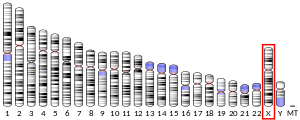Cationic amino acid transporter 3
Cationic amino acid transporter 3 is a protein that in humans is encoded by the SLC7A3 gene.[5][6]
SLC7A3 is a member of the system y+ family of transporters characterized by sodium-independent transport of cationic amino acids.[supplied by OMIM][6]
See also
References
- GRCh38: Ensembl release 89: ENSG00000165349 - Ensembl, May 2017
- GRCm38: Ensembl release 89: ENSMUSG00000031297 - Ensembl, May 2017
- "Human PubMed Reference:". National Center for Biotechnology Information, U.S. National Library of Medicine.
- "Mouse PubMed Reference:". National Center for Biotechnology Information, U.S. National Library of Medicine.
- Vekony N, Wolf S, Boissel JP, Gnauert K, Closs EI (Oct 2001). "Human cationic amino acid transporter hCAT-3 is preferentially expressed in peripheral tissues". Biochemistry. 40 (41): 12387–94. doi:10.1021/bi011345c. PMID 11591158.
- "Entrez Gene: SLC7A3 solute carrier family 7 (cationic amino acid transporter, y+ system), member 3".
Further reading
- Hosokawa H, Sawamura T, Kobayashi S, et al. (1997). "Cloning and characterization of a brain-specific cationic amino acid transporter". J. Biol. Chem. 272 (13): 8717–22. doi:10.1074/jbc.272.13.8717. PMID 9079705.
- Ito K, Groudine M (1997). "A new member of the cationic amino acid transporter family is preferentially expressed in adult mouse brain". J. Biol. Chem. 272 (42): 26780–6. doi:10.1074/jbc.272.42.26780. PMID 9334265.
- Hosokawa H, Ninomiya H, Sawamura T, et al. (1999). "Neuron-specific expression of cationic amino acid transporter 3 in the adult rat brain". Brain Res. 838 (1–2): 158–65. doi:10.1016/S0006-8993(99)01686-8. PMID 10446328.
- Strausberg RL, Feingold EA, Grouse LH, et al. (2003). "Generation and initial analysis of more than 15,000 full-length human and mouse cDNA sequences". Proc. Natl. Acad. Sci. U.S.A. 99 (26): 16899–903. doi:10.1073/pnas.242603899. PMC 139241. PMID 12477932.
- Ota T, Suzuki Y, Nishikawa T, et al. (2004). "Complete sequencing and characterization of 21,243 full-length human cDNAs". Nat. Genet. 36 (1): 40–5. doi:10.1038/ng1285. PMID 14702039.
- Gerhard DS, Wagner L, Feingold EA, et al. (2004). "The status, quality, and expansion of the NIH full-length cDNA project: the Mammalian Gene Collection (MGC)". Genome Res. 14 (10B): 2121–7. doi:10.1101/gr.2596504. PMC 528928. PMID 15489334.
- Gilles W, Vulcu SD, Liewald JF, et al. (2005). "Monovalent cation conductance in Xenopus laevis oocytes expressing hCAT-3". Biochim. Biophys. Acta. 1668 (2): 234–9. doi:10.1016/j.bbamem.2004.12.011. PMID 15737334.
- Otsuki T, Ota T, Nishikawa T, et al. (2007). "Signal sequence and keyword trap in silico for selection of full-length human cDNAs encoding secretion or membrane proteins from oligo-capped cDNA libraries". DNA Res. 12 (2): 117–26. doi:10.1093/dnares/12.2.117. PMID 16303743.
- Rotmann A, Vékony N, Gassner D, et al. (2006). "Activation of classical protein kinase C reduces the expression of human cationic amino acid transporter 3 (hCAT-3) in the plasma membrane". Biochem. J. 395 (1): 117–23. doi:10.1042/BJ20051558. PMC 1409692. PMID 16332251.
This article incorporates text from the United States National Library of Medicine, which is in the public domain.
This article is issued from Wikipedia. The text is licensed under Creative Commons - Attribution - Sharealike. Additional terms may apply for the media files.



